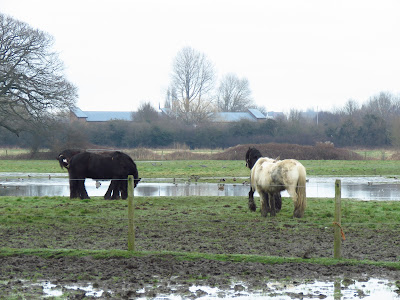The day started frosty and sunny, then it clouded up. I headed West via Perth Street, then cut across the pedestrian path and bridge over the railway line to Spring Bank West and then followed Wold Road to Willerby Carrs. The rain in the last couple of weeks has filled the carrs and there are plenty of pools. On Willerby Carr farm I see my target bird: Wigeon (new for #localbigyear, now at 73 sp). A flock of about 35 feed by the water with about 50 Teal a sprinkle of Mallard and Black-headed Gulls. The horses are let into the field and they gallop across the water, flushing the birds. A Skylark sings from the arable fields.
Rook calling.
Wigeon, Teal and gulls and gulls.
One of the farm's horses.
Grazing Wigeon.
Teal.
Afterwards I move onto Willerby Carr Dyke area. It is wet and muddy. The starlings are flushed and Magpies and Crows are uneasy. The cause of the commotion appears flying over and settling on a hedge: a female Sparrowhawk. A Little Egret flies over, in the direction of the dyke. I caught up with it but it is soon flushed by a dog walker.
Willerby Carr Dyke.
Little Egret.
I scan the fields to the north and spot a Grey Heron and a Fox.
Grey Heron.
Great Spotted Woodpecker. It was chased by a male Chaffinch, before posing atop an ash like so.
Buzzard flyover.
I retrace my steps and walk through the golf course by the public footpath. It is very quiet, no golfers and few birds, but a few molehills. I leave the gold course and start my return home via Hotham Road South, over the railway line and by the Setting Dyke. Overall a pleasant 15k circular walk.
This veteran Alder stands by Wynersley Road near Springhead Gold Course, the largest I've ever seen. It is hard to do it justice with photos. I check and I'm pleased it is already on the
Woodland Trust Ancient Tree Inventory. I'm surprised to find out that Alder can live for just up to 200 years, so this tree must be coming to the end of its life; it lost the top and it's hollowed up.

















No comments:
Post a Comment